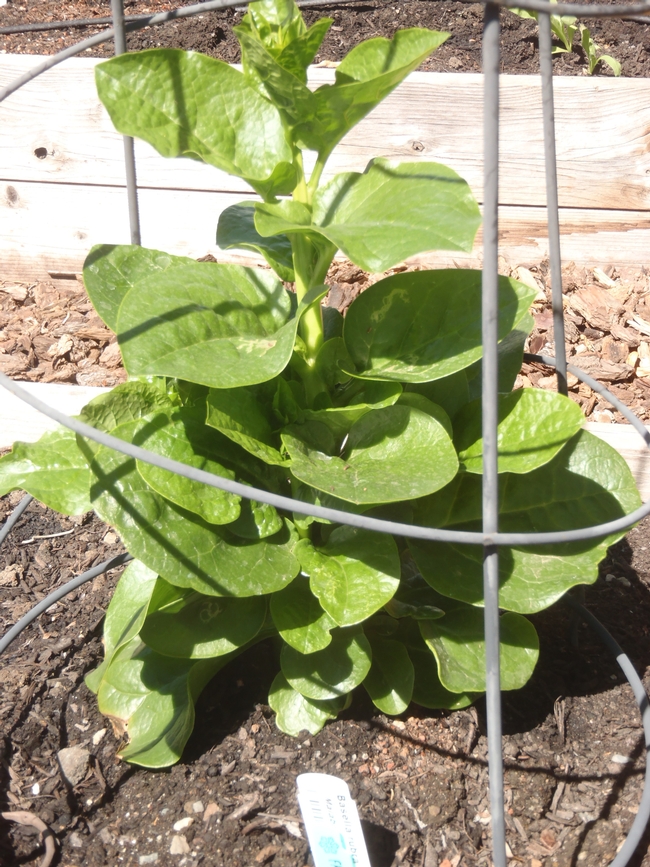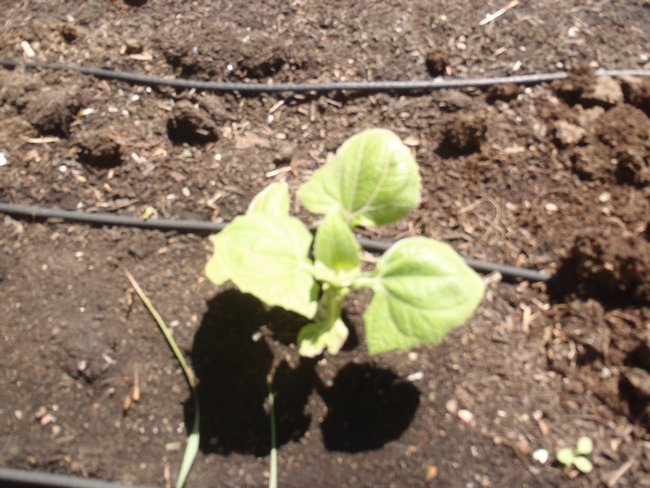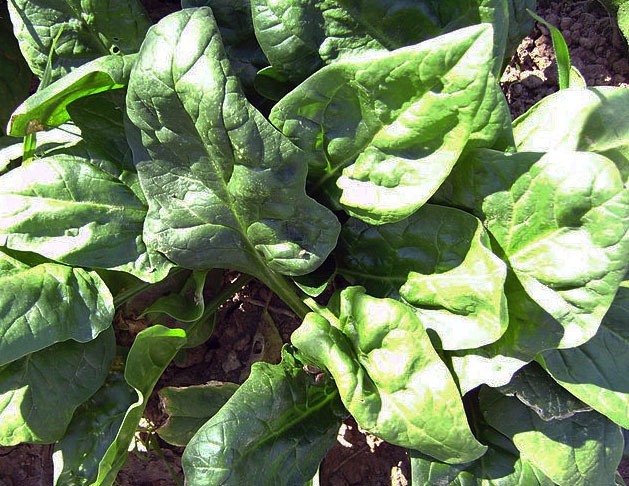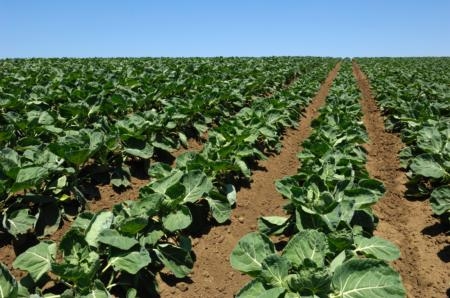Posts Tagged: spinach
UC Cooperative Extension advisors help spinach growers finesse fertilizer applications
UC Cooperative Extension advisors are studying the critical balance between fertilizer application and absorption in Salinas Valley spinach crops to help farmers meet new water regulations, reported Dennis Taylor in the Salinas Californian.
Richard Smith and Michael Cahn, UCCE advisors for Monterey and other Central Coast counties, have been conducting field trials for several years to determine volume data on fertilizer application. Once growers know exactly how much nitrogen their crop is absorbing, they can more precisely apply an appropriate amount.
Smith explained that baby spinach will absorb roughly 80 percent of the nitrogen it is going to take up in the final two weeks before harvest, making timing critical, Taylor reported. Spinach harvested a few days later, called "teen spinach" uses about 100 pounds of nitrogen per acre; larger-leafed spinach can used up to 120 pounds.
“No (previous) studies had evaluated high-density planting of clipped or bunched spinach grown on 80-inch beds,” said UCCE research assistant Aaron Heinrich. “Our study was specifically designed to provide data on the nitrogen uptake characteristics of spinach and to evaluate ways to improve nitrogen fertilizer management.”
Exotic Perennial Vegetables of the Month: Yacon and Malabar Spinach
When gardeners speak of “perennial vegetables,” the edible plants that often come to mind include asparagus, rhubarb, and artichoke. The purpose of this article is to introduce you to other rare and/or unusual perennial vegetables which may be worth cultivating in your own backyard garden.
My quest for rare and unusual perennial vegetables led me to a plant sale recently held at the Occidental Arts & Ecology Center in Occidental, California (see www.oaec.org for more information). Although I purchased a number of perennial vegetables at the sale, most of which I have no experience growing, this article will feature two of those plants, which seem to be thriving thus far in my Solano County backyard garden. I will report back on other weird and wonderful perennial vegetables in the coming months, depending on how well they fare.
I had been searching for yacon (Polymnia sonchifolia), also known as Bolivian Sunroot, for quite some time, and was thrilled to have found it at the OAEC plant sale. Yacon is considered one of the “Lost Crops of the Incas.” Yacon is a relative of the sunflower and and native to the high Andes. Although my yacon plant is currently 5 inches tall, the literature I have read indicates that my yacon plant should reach 5-feet tall at maturity. To harvest yacon, the tubers are dug up in the autumn (so I have another a year to wait). Yacon is a versatile plant, as it can be eaten raw like fruit, or can be stir-fried, roasted, baked or made into pies and chips. Some cultures use the leaves of the yacon plant with which to wrap their food. Although I have never tasted yacon as it is not readily available in the markets that I shop at, I have read that yacon tastes like jicama, only better. Another description that I found, said that yacon tastes like a cross between celery and a Granny Smith apple. Yacon is best grown in full sun and in well-drained, fertile soil.
In recent years, yacon has grown in popularity, both in gardening literature and in nurseries specializing in rare plants. This may be due to the fact that yacon is an up and coming “super food,” as food companies are developing yacon into various products such as yacon syrup, which is a low-calorie sugar substitute appealing to both diabetics and people on diets.
Although I debated whether to buy malabar spinach (Basella rubra) at the OAEC plant sale, I gave in, as I knew malabar spinach to be a staple for those interested in permaculture/creating an edible food forest in their backyards. It is not actually spinach, but has the flavor of spinach, and can be substituted in recipes which call for spinach (note that malabar spinach is fleshy and mucilaginous, and is best consumed cooked and not raw). Under the right conditions (e.g., full sun, and fertile, well-drained soil), malabar spinach which is a vine requiring trellising, can reach 8-10 feet in length. Because malabar spinach is so prolific, I have read that one vine is sufficient to feed a family of 4. Malabar spinach is frost tender and may need to be dug up and brought indoors during the winter.
I will report on other unusual perennials growing in my backyard in the coming months, so stay tuned for updates.

Malabar spinach. (photos by Betty Homer)

Yacon
Spinach safer five years after E. coli outbreak
Salinas Californian reporter Andy Stiny wrote a story on the 5th anniversary of the E. coli outbreak in spinach grown in San Benito County. He reported that Steve Koike, plant pathology farm advisor for Monterey County, said California's spinach industry is rebounding from the setback. Bonnie Fernandez-Fenaroli, executive director for the Center for Produce Safety at UC Davis, is quoted as saying, "A lot of research is going into all produce right now." The center has 54 produce safety projects under way. Christine Bruhn, a food marketing specialist and director of the Center for Consumer Research at UC Davis, said recent surveys show consumers are more concerned about meat products but 30 percent said they are concerned about produce safety. "We advise people to wash their sink and their hands, then wash produce in running water and dry with a clean paper towel," Bruhn told the reporter. "This reduces but does not eliminate bacteria."
UC Berkeley professor appointed to systemwide position
Sybil Lewis, The Daily Californian
UC Berkeley professor Barbara Allen-Diaz has been appointed University of California systemwide vice president for Agriculture and Natural Resources, reports the Daily Californian, the UC Berkeley student newspaper.
UC food safety research on the national news
Last Saturday night, the CBS Evening News aired a six-minute special report on food safety. The research component for the story featured an appearance by UC Davis Cooperative Extension food safety specialist Linda Harris, in which she explained work underway to understand the potential food safety impact of irrigation practices on leafy green vegetables.
Reporter Bill Witaker noted that cutting edge research is being conducted around the country to find out how pathogens make it onto fresh produce and how to reduce the risk. He used the UC Davis Center for Produce Safety as a case in point.
Interviewed inside her lab, Harris told Whitaker the effectiveness of her work is "hard to prove, it's hard to measure, but I really think we do make a difference."
UC research isn't confined to laboratories. Three UC Cooperative Extension farm advisors in Monterey County - Steve Koike, Richard Smith and Michael Cahn - are working with campus-based researchers to determine the ability of the deadly E. coli 0157:H7 to survive in the field.
They reported in UC Delivers that they used harmless E. coli as surrogate organisms to evaluate how variations in soil moisture and environmental conditions impact the organism's survival in soil, water and on plant surfaces. In addition, experiments on E. coli source-tracking, detection technologies and field ecology are being conducted to gather information from an environment that reflects the actual farming conditions of the local agricultural industry.

UC scientists are helping protect the safety of the U.S. food supply.



